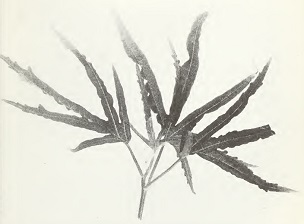From Edible Leaves
Of The Tropics, U.S. Department of Agriculture
by Franklin W. Martin and Ruth M. Ruberté
Malvaceae
Figure 11 
The sulfur colored leaves of Hibiscus
manihot.
Hibiscus
species are native to the Old and the New World, and are
widely scattered by the action of man. The young leaves and even mature
leaves particularly of the African, but also of the Australian species
are often used for food. For purposes of this presentation only the
most important food bearing species are mentioned, but others are
included in the appendix. These are H. sabdariffa L.
(Roselle,
Rosella). H. acetosella
Welw. ex Fic. (False roselle), and H.
cannabinus L. (Kenaf). They are plants of African origin
possibly
domesticated in the Sudan but well distributed throughout tropical
Africa. The first two species serve as a commercial source of fibers.
Roselle, however, is better known as a vegetable of high quality. The
forms used for fibers are distinct from those used as food, but all are
edible. Roselle has been adequately treated in a review with kenaf and
other Hibiscus
species by Wilson and Menzel (1964).
A description of these species is difficult for each consists of
numerous disparate varieties. The principal food producing form of
roselle is a woody annual herb that is much branched, with glabrous or
almost glabrous foliage. The fibrous forms are more erect. The leaves
are green, and vary from entire to palmately divided. The stems are
deep red. The attractive flowers, yellow with red center, are borne
solitarily in the axils of the leaves, and the red, acidic calyx of
these becomes enlarged and succulent. Plants of H. acetosella are
very
similar to some of those of roselle. It occurs in two main forms, one
with bronze-green leaves and yellow flowers, and the other with
entirely red foliage and usually pink flowers. The calyx is small, not
fleshy, and
not eaten. These species have the advantage over kenaf of resisting
nematodes. Kenaf, on the other hand, is a very woody, green-leaved
shrub that grows to heights with little or no branching. It is chiefly
used as a fiber source and has been extensively bred for that purpose.
It is highly susceptible to root-knot nematodes.
Most varieties of roselle and kenaf are very susceptible to the length
of day (photoperiod) although the latter is probably more sensitive
than the former. Plants of even 15 centimeters can be induced to bloom
by daylengths of 9, 10, or 11 hours. The sensitivity of particular
varieties varies. Roselle is often used as a laboratory example of
photoperiodic effects because of this sensitivity. Thus, time of
planting exercises a profound effect on morphology of the plant.
Practically all parts of roselle are edible. The species is appreciated
for the fleshy bases of the buds. These, when cooked, form a colorful
sauce not unlike that from cranberries. The colorant is widely used in
the preparation of jams, jellies, and other products. The seeds are
eaten toasted, and in fact, the plant may have been domesticated for
its edible seeds. The leaves and the tender shoots are sometimes eaten
raw in salads, but are usually cooked, becoming somewhat mucilaginous,
and reminiscent in texture and taste of rhubarb. The acid flavor is
seldom excessive, and is easy to learn to enjoy. It is distinctive and
lingering.
The leaves of H.
acetosella are used. in much the same way as those of
roselle but they tend to be more sour. Upon cooking much of the
anthocyanin coloring is lost, and the cooked dish may not be
attractive.
Leaves and shoots of glabrous forms of kenaf are equally edible, are
cooked as spinach in Africa and India. Removing the shoot of kenaf
changes the growth habit, however, and makes the plant less useful for
fiber. In Africa, where these species are so appreciated, the leaves of
another vegetable, okra (Hibiscus
esculentus L) are eaten in the same
fashion.
All the edible Hibiscus
species are propagated by seeds, which are
produced in abundance. These can be sown directly if the soil is
properly prepared. Because of the long tap roots of roselle, a
particularly deep, loose soil is desirable. Hibiscus species
are fairly
tolerant of distinctive soil types but require good drainage and
benefit from mulching and fertilization. The nematode-susceptible
varieties grow poorly and produce little in infested sandy soils.
Plants grown for fiber are seeded in ridges at very close spacing.
Individual plants of roselle may grow to a very large size, and thus
need spacing distances of a meter or more. Roselle plants grow slowly
in contrast to those of kenaf. To obtain maximum size, they are
therefore seeded early in the rainy season when daylengths are
increasing.
Because of their color and normal tendency to branch, false roselle
plants may be grown as a colorful, temporary hedge. Pruning the hedge
to shape and harvesting the leaves are one and the same operation.
Under such conditions the amount of edible material produced in a small
space is quite large.
The useful life-span of the plants of both roselle and kenaf is brought
to a close by flowering during short days. Seeds are borne in
abundance.
Because of its many uses, roselle merits its place in the home garden,
and can contribute to a variety of dishes.
|
|

